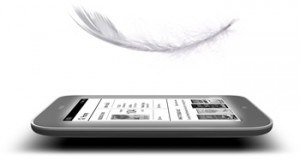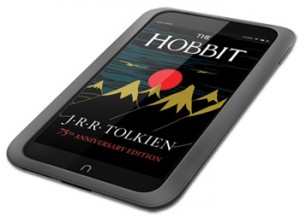Could it be the end of the line for Nook devices? Given their sluggish holiday sales and a subsequent flurry of rumors predicting their demise, it seems a distinct possibility.
At press time, it was unclear how long Barnes and Noble (B&N) would continue marketing Nook-branded hardware.
B&N sent me a pair of Nook models late last winter. I liked both, but tabled my reviews when rumors surfaced in February that B&N might close its hardware side and focus on app-based content sales through third-party devices. Speculation then intensified as B&N offered discounts and freebies to accelerate stalling sales, then opened up the limited Nook tablet ecosystem in May to allow Nook HD and HD+ users to access all Android apps and content.
Then reports swirled that Microsoft, holding a 17 percent stake in Nook Media, B&N’s
digital content and devices arm, was poised to bid a billion dollars to buy the division outright.
That would allow Microsoft to compete with industry rivals who were already content providers, like Apple and Google. Some predicted that Microsoft would include preinstalled Nook apps on upcoming mobile devices powered by Windows 8 RT. Meanwhile, B&N stock prices, up nearly 25 percent when Microsoft rumors peaked, dropped as they subsided. I’ll keep you posted on all things Nook as the facts shake out, so stay tuned. Meantime, here’s my take on two Nook devices.
Nook Simple Touch with “GlowLight”

Barnes & Noble was the first to boast that their Nook Simple Touch reader with GlowLight ($119, at left) was as as readable in a dark bedroom as it is on a sunny beach and is the best dedicated ereader on the planet. Its sole focus is delivering a comfortable, elegant textual experience, period.
Beyond the built-in WiFi allowing B&N bookstore purchases and downloads, librarians will appreciate that the Simple Touch handles DRM-protected EPUB and PDF files transferred via USB, making it library-loan friendly. Under seven ounces and with totally intuitive controls, low-key design, and a nimble, six-inch, 600 x 800 touchscreen, the Simple Touch can be unboxed, charged up, and used without even thinking about it.
That’s how I like my gadgets. The GlowLight feature is an easily activated, adjustable light from eight LEDs that gently illuminate the E Ink Pearl screen from the front. It’s perfect for nocturnal readers who don’t want to disturb their snoozing bedfellows.
The GlowLight cuts the use-per-charge time roughly in half, but B&N still promises “over a month” of reading time with the GlowLight on and WiFi off. You can expect about 15 hours of GlowLight reading per charge.
Nook HD (8 GB) 7-inch tablet
 When released in November 2012, the Nook HD ($199, above right) was a “walled garden” device, only offering access to B&N-approved content and apps. Following the poor holiday sales, B&N opened up access to the Google Play store on its HD and HD+ (nine-inch) tablets in early May. That gave users access to over 700,000 Android apps and a constellation of Google services including the Chrome browser and Google apps.
When released in November 2012, the Nook HD ($199, above right) was a “walled garden” device, only offering access to B&N-approved content and apps. Following the poor holiday sales, B&N opened up access to the Google Play store on its HD and HD+ (nine-inch) tablets in early May. That gave users access to over 700,000 Android apps and a constellation of Google services including the Chrome browser and Google apps.
A Mother’s Day promotion offered the 8GB HD for $149, probably boosting spring sales. But adding Google Play Store came at a price for B&N, allowing users to buy content from Amazon, Google, and Kobo.
The 8GB Nook HD was worth the $199 price. It has the highest resolution display (1400 x 900, 243 pixels per inch) of any seven-inch tablet. Compare that to the iPad Mini with its 163-pixel-per-inch display. I didn’t mind the Nook HD’s lack of cameras. It has the stuff to handle most multimedia: a headset jack, a mic, rear-facing stereo speakers, and the ability to play 720p video. At just over 11 ounces, it’s 2.8 ounces lighter than the Kindle Fire HD.
My only complaint was occasional sluggishness with lots of apps running. Sometimes, the carousel menu was unresponsive. Fortunately, the Advanced Task Killer app fixed that.
I wasn’t a big fan of the first 2009 Nook. But I’ve warmed to Nooks as they’ve risen to the top of the heap. I’ve always appreciated that Nooks were ebook loan friendly, and I hope they will compete and survive. Visit Barnes and Noble for information on all Nook devices.
Jeffrey Hastings (hastingj@howellschools.com) is a library media specialist at Highlander Way Middle School in Howell, MI.



“Boasting the only E Ink display as readable in a dark bedroom as it is on a sunny beach”
You might want to fact check your article.
Why, Nate, what are you seeing? I’ve heard rumors of competing front-lit eInk readers, but not seen any yet.
Seriously? Kobo has 2 front-lit ereader (Glo and Aura HD), Amazon has one (Paperwhite), Pocketbook has a couple, and even Onyx has a front-lit ereader on the market.
The long-breaking news about Nook is disconcerting, but I’ll be in it for the long-haul (or short, depending on the prevailing winds). When the time came for me to choose an eReader, I was immediately put off by the devices which claimed to do it all. Kindle seemed too busy on the design level. I wanted an intuitively controlled device for reading. Period. My original Nook was a simple device that was actually easier to read than a paper page, especially in odd light and it weighed much less than a 500 page trade paperback. Now I use the first gen. tablet, mainly for color so I can also read my periodical subscriptions. One thing I’ve noticed that hasn’t helped B&N is the fact that many series authors and indie authors lock themselves into kindle formats through Amazon KDP select. I’d like to read many of these, especially when they’re offered free, but they don;t bother releasing them for Nook, or Kobo — both viable eBook markets. I don;t understand why some authors feel they don’t need to cover all the bases, but that seems to be the way it works. I make sure my own titles are available in every possible format and in print. I never want to have to say “Sorry.” to a potential reader.